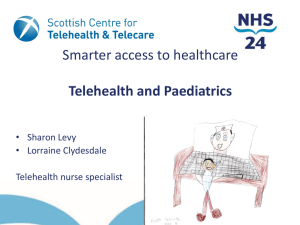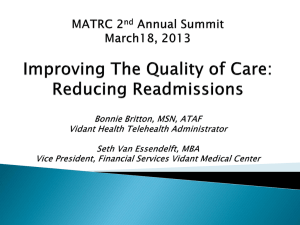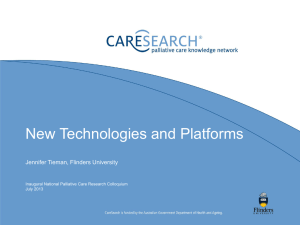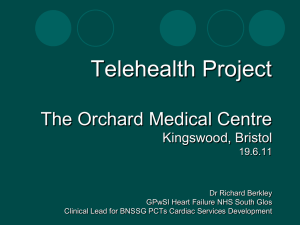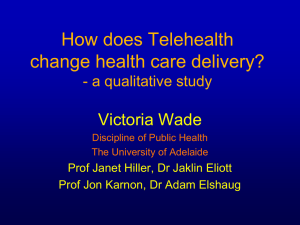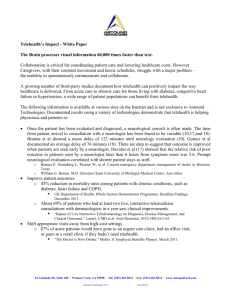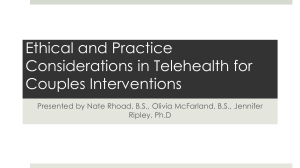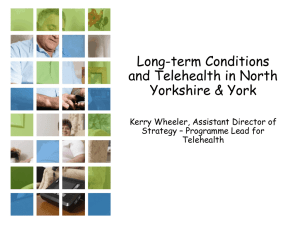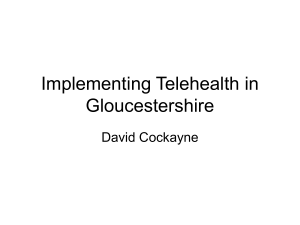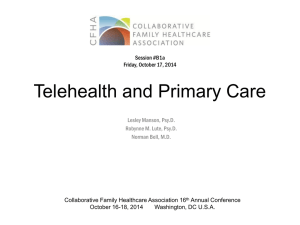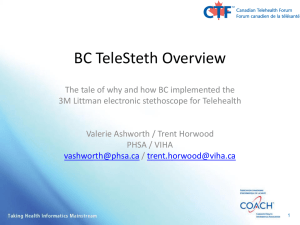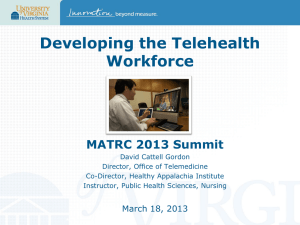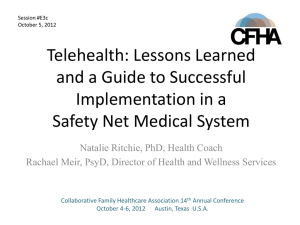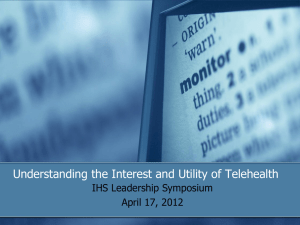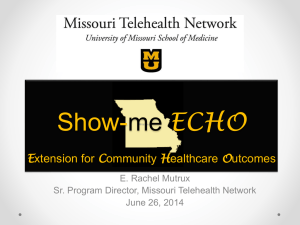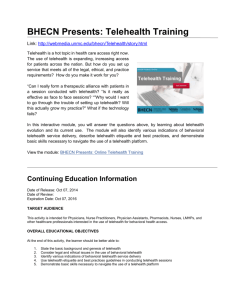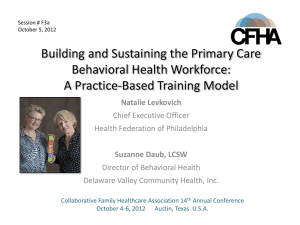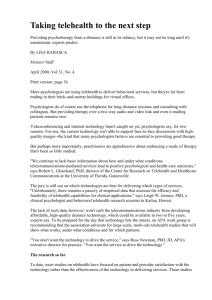What BHC Looks Like at LCHC? - Collaborative Family Healthcare
advertisement
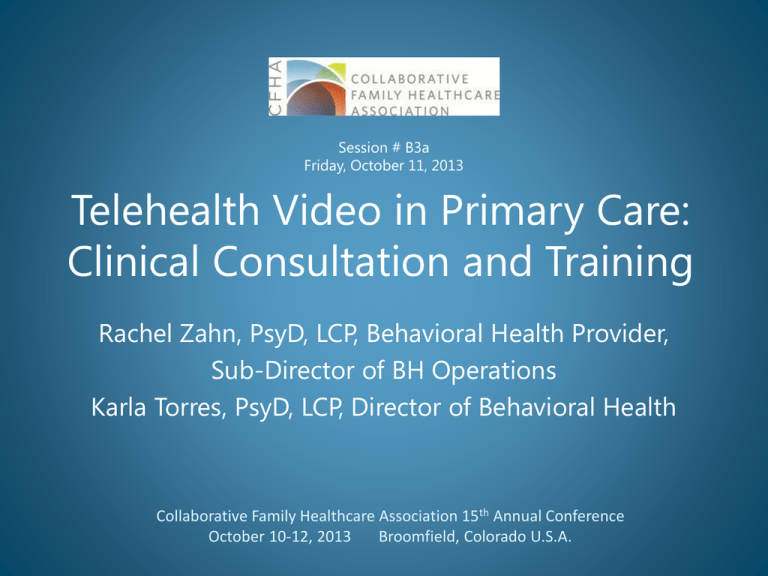
Session # B3a Friday, October 11, 2013 Telehealth Video in Primary Care: Clinical Consultation and Training Rachel Zahn, PsyD, LCP, Behavioral Health Provider, Sub-Director of BH Operations Karla Torres, PsyD, LCP, Director of Behavioral Health Collaborative Family Healthcare Association 15th Annual Conference October 10-12, 2013 Broomfield, Colorado U.S.A. Faculty Disclosure We have not had any relevant financial relationships during the past 12 months. Disclaimer • We do not discuss in this presentation any specifications on telehealth video equipment or software to use as this is not the focus of our presentation rather it is the clinical value and uses for telehealth video in mental health. Objectives • Develop a different approach to providing clinical consultation and supervision of trainees • Identify the usefulness of implementing telehealth video to provide behavioral health services specific to our clinic • Identify challenges and limitations of using telehealth video for behavioral health within primary care • Outline methods of supervision to trainees within the behavioral health consultation model History of the BH Department 2004 Joined APA accredited consortium 2004-2006 1 psychologist and and 1 pre-doc intern serving all 3 sites 2007 1 psychologist, 1 post-doc resident, 2 pre-doc interns 2010 First use of Telehealth with OB patients 2012 Use of Telehealth for supervision and consultation with other professionals 2013 • 8 licensed clinicians: 7 which are psychologists, 2 post-doc residents, 1 pre-doc intern • 5 sites serving over 8,000 patient visits a year • 5 bilingual psychologists, English/Spanish • Current ratio approx about 8-10 providers per Behavioral Health Provider (BHP) • Populations predominantly low income, uninsured, chronic mental illness and substance abuse. Culturally diverse with large ratio of African-American and Latino populations What it looks like… Provider Area Exam Rooms Hallway Next BHC F/U = PCP = BHC Diabetes, Insomnia, Substance Abuse, Anxiety, Mood d/o What BHC Looks •Like at LCHC? Immediate and open access to carePCP is able to make personal referral to the BH provider. • Maximize patient time as they wait • Maximizes PCP efficiency during patient visit Telehealth Implementation • Equipment: – TV or laptop (with built-in or camera attached), microphone/speakers, laptop cart, cable connection/wifi • Setup: – Stationary TV (designated BH room) – Mobile laptop cart (able to move between exam rooms) Type of Use • Consultation – BHP Solo: OB screenings alongside care team – Side by Side: 1 BHP in room/ 1 BHP on video (supervising) – Consultation with PCP and care team • Training – Shadowing – Supervision (live) EMR facilitates remote access Research and Experience • Research: – Studies have found patients benefit and are not harmed by telemental health – Effective for various disorders (agoraphobia, panic d/o, psychotic) • Studies compared in-person vs video interviews in psychotic patients concluded that even those with delusions pertaining to the TV, responded appropriately to video and did not incorporate their experience into their delusional system. • Experience: – Anecdotally, patients have responded positively about their experience noting no difference whether in-person or on video, more so noting the benefit of seeing a BHP during their visit regardless of method used (formal piloting of research currently underway) Tele mental Health: Expanded • Other Uses – Training – Supervision – Consultation with professionals across different sites • Advantages – Cost-effective live supervision v two waymirror – Flexible, convenient and versatile – Remote access supervision • Limitations to consider – APA guidelines: not to take the place of face to face supervision – Equipment/technical troubleshooting Guidelines for use of Telemental health • Use of telehealth video and appropriate protocols shall be coordinated with the remote health center in accordance with applicable jurisdictional law and licensing requirements. • Practice standards provided by American Telemedicine Association • http://www.americantelemed.org/docs/defaultsource/standards/practice-guidelines-for-videobased-online-mental-healthservices.pdf?sfvrsn=6 Resources www.americantelemed.org http://www.apapracticecentral.org/update/201 0/08-31/telehealth-resources.aspx Telemental Health (Myers & Turvey, 2012) References • Sharp IR, Kobak KA, Osman DA. The use of videoconferencing with patients with psychosis: a review of the literature. Annals of general psychiatry 2011;10(1):14. • Dongier M, Tempier R, Lalinec-Michaud M, Meunier D. Telepsychiatry: psychiatric consultation through two-way television. A controlled study. Can J Psychiatry. 1986;31(1):32-4. • Bouchard S, Paquin B, Payeur R, Allard M, Rivard V, Fournier T, et al. Delivering cognitive-behavior therapy for panic disorder with agoraphobia in videoconference. Telemed J E Health. 2004;10(1):13-25. Learning Assessment Audience Question & Answer Session Evaluation Please complete and return the evaluation form to the classroom monitor before leaving this session. Thank you!

